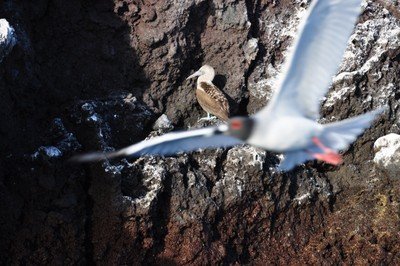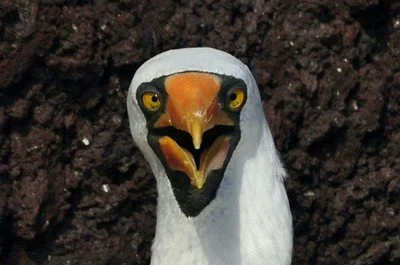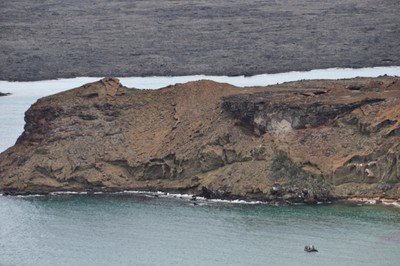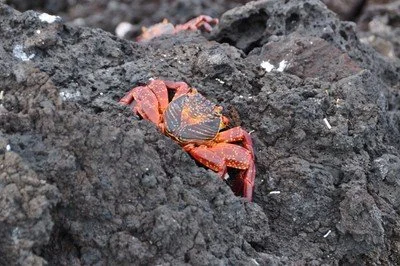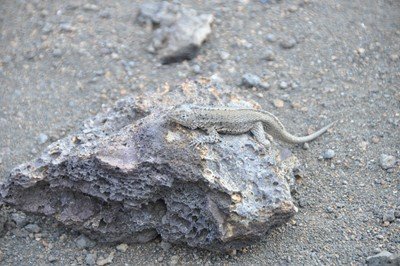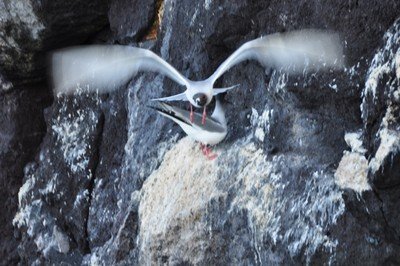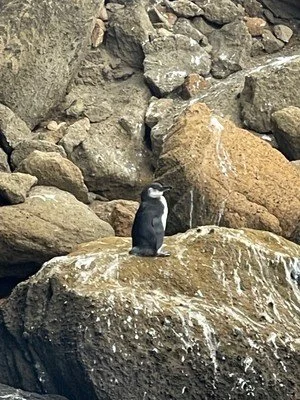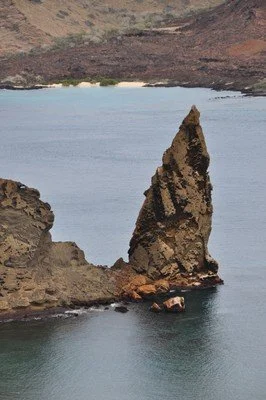4. Bartolome, Santiago, Buccaneer Cove
Greetings, humans. Welcome to our home. Please leave nothing and take nothing.
06.19.2022 - 06.19.2022 75 °F
Day 4, Sunday, June 19
The Silver Origin provides us with high quality Alessi masks and snorkels, waterproof Silversea logo backpacks, raincoats and a refillable water bottle—no plastic is allowed on board. The typical day will require all of this as there are usually three excursions available—hikes, walks, beach snorkeling, deep-sea snorkeling and kayaking.
Today’s agenda: Bartolome, Santiago and Buccaneer Cove. We position ourselves in Sullivan Bay, gazing at the remnants of volcanic activity that leaves a surface reminiscent of the surface of the moon. Santiago is an island of 226 square miles and home to marine iguana, sea lion, fur seals, sea turtles, dolphins and sharks. Darwin’s Finches and Galapagos Hawks and Galapagos Penguins are also here. The Santiago giant tortoise roams inland but we won't see them today. We complete the day having seen only lava lizards, crabs, sea turtle nests, sea lions and a few birds.
Aboard Zodiacs, we are transported to the beach at Bahia Dorado where we encounter a few small lava lizards enroute to a 388-step climb up a boardwalk to enjoy a gorgeous panorama in the direction of Pinnacle Rock. The landscape is a moonscape of very dry powdered lava with precious little vegetation. In the distance are Baltra Daphne Major and Daphne Minor.
Far far below me, I spot B4 in a Zodiac doing a coastal cruise as she opted to skip the steep stairs up the hillside. After completing it, I believe she made the wise choice. I've asked her to describe her journey without me:
My more favored activity takes place down the hall from our suite at the spa, however this morning was different. Up and out of our cabin bright and early at 7:15am to see wildlife - who would have believed it....but there is lots to see here.
The first bird we see is a blue footed Boobie, relatively common in the Galapagos but not indigenous to the islands. Paul talked about how they got their name in an earlier blog. I know what it is like going through life with an unusual name. Sometimes it isn't fun but i'll take 'Beryl' over 'Boobie' any day. One interesting piece of trivia about a Boobie is when they feel like a meal and dive to catch a fish, they hit the water at about 70 miles an hour. That could hurt but they make it look easy and seamless. There is no particular mating season for Boobies, it's whenever the mood strikes. But when the mood strikes they do the 'Boobie dance' and the female gets to pick her male. Most attractive to her is a male with deep bright blue color legs. That bright color tells her he is healthy, well feed, strong, and able to provide food. Clearly the Boobie in the pic here doesn't make the cut. I guess Blue is the color of birds here as another one we saw this morning is the Blue Heron. Why it is called as such I can't explain, I see no blue. The lava heron is indigenous to the islands. It is hard to spot since it is the color of the lava rocks on which it sits. Sea food is abundant here but if you chose oysters for dinner it is an imperative you catch yours before the red beaked 'oyster catcher' bird beats you to it. If your preference is crabs for dinner you may be out of luck. There are 'Sally light foot' crabs everywhere, named for a woman named Sally who first found them. They are quite edible but protected so only the birds and the sea lions get to enjoy them. We think of penguins as cold water, cold geography birds this travel in huddles. However the Galapagos is home to tiny little penguins, the third smallest of the breed, that are solitary. It's a good thing there is no speed limit in the Pacific ocean because these penguins swim at 50 miles an hour. A young one stands here surveying the area around. How do I know it is a young penguin? Because its white fur around its neck is not ringed with black. Paul had a great sea lion experience on his hike, my sea lion encounter was more sedentary but i thought my pic was pretty good so i included it. So there you have it, more birdlife than i have experienced in my entire 71 years.
On expedition cruises, one becomes familiar with what is known as, “The Zodiac.” I got very accustomed to these small mostly rubber boats in the Arctic, the Antarctic, and on whale shark or orca or other whale watching trips. I’ve been aboard them in frigid ice-clogged under-the-iceberg conditions and in peel-off-your-shirt steamy-water dead-calm conditions. Here, we glide adjacent to the beach to watch a Galapagos Seal bathe.
But how much do I really know about Zodiacs? The word “Zodiac” is a registered trademark owned by the Zodiac Nautic Company of France which manufactures these craft in France, Tunisia and South Carolina. In financial difficulty, the company went private in 2015. It was formed for the purpose of manufacturing airships, a business that collapsed along with the Hindenburg back in 1937. About that same time a Zodiac engineer, Pierre Debroutelle, invented the precurser of today’s Zodiac.
The Zodiac boat itself is a RIB—rigid inflatable boat. It sports a rigid bottom married to compartmental air tubes which create the side of the hull. There is so much air in these buoyancy tubes that Zodiacs would stay afloat even if completely filled with water. Silver Origin carries eight Zodiacs.
Here in the Galapagos, our Zodiacs will host us in average June weather which is a low of 72 °F and a high of 75 °F. The seas should be mostly calm as they are sheltered by all the islands themselves. In other words, not hot and not cold but, if you’re wet and the open boat is moving briskly through the water, it would feel chilly.
The Zodiac process features us being divided into disembarkation groups which are rotated so that the same group doesn’t always enjoy the privilege of being first to disembark for whatever adventure awaits. Each Zodiac has an experienced driver/expert guide. Sometimes we will make “Dry Landings” meaning we disembark onto a dock or other landing platform. More often we make “Wet Landings” where we flip our legs over the rubber pontoon sides and then drop down into shallow water, wading to shore. We have water shoes which are ideally suited for this. Of course, we are warned ahead of time how to dress for which of these landings is in store. Safety vests are mandatory aboard Zodiacs. Ecologically friendly sunscreen is made available to us and sunglasses are highly recommended.
We hop aboard to make a run to the beach to snorkel. B4 heads for the beginner group and I opt for the deep water group. We are happy with our respective choices. I take my GoPro with me and am lucky enough to get one good scene. Note the ray on the bottom and watch for my new friend to swim across the screen.
Shuttling via Zodiacs, Buccaneer Cove is next. On Santiago—or James Island—this spot drew pirates in search of food and water and, perhaps, hiding places for stolen treasure. There are caves carved into the rocks—one called Bishop’s Rock. The area is dotted by Prickly Pear Cactus and Palo Santo trees. From cruising Zodiacs, we see lots of boobies: Nazca Boobies, Blue Footed Boobies and even some Swallow-Tailed Gulls.
The non-migratory Galapagos Sea Lions welcome humans to their swim adventures. They fear sharks and killer whales but not us human beings. Smaller than California sea lions, they are the most populous “land animal” in these islands. The local population (estimated to be between 20,000 to 50,000 individuals) stay relatively close to shore while hunting fish for food and seems to love to lounge or sleep on flat sandy beaches.
These sea lions are not to be confused with the local Galapagos fur seals which are about half as big. They get their name from having, when dry, much thicker fur which is black in the water but dries to a gold color. Fur seals have big eyes and ears and prefer rocky shores to sandy beaches and are most often sighted here on Bartholome and Santiago Islands and on the southern shores of Floreana.
Marine iguanas are the world’s only sea-going lizards. Each island here, however, hosts its own subspecies. Those found near Espanola and Floreana are more colorful, capable of turning bright green and red. Males fight for control of harems of females. Their relative lack of agility on land is made up by their swimming skills as they look for algae upon which they feed. If you look closely at their snouts, you may see salt crystals—they have so much salt content in their diet that their bodies have developed a blood filtering system and they sneeze out all that excess salt.
There is so much here to learn, to absorb and to ponder. We attended a photography lecture, the kayak briefing where we learned that we are not good prospects for that activity and then a nap before another Zodiac cruise, this one at 4:45 when the sun is preparing for its 6:00 setting. These guys are on our route.
Tonight, Silver Origin sails to a new destination. We cross the equator tonight; twice.

